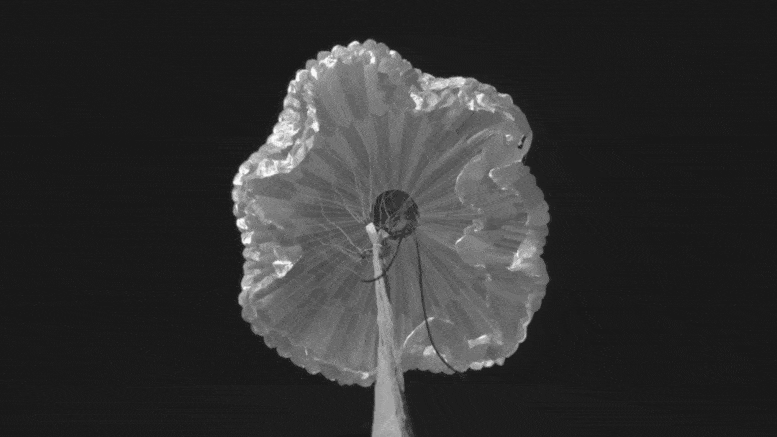
This animated GIF shows a successful test of the parachute that will be used to land NASA’s Perseverance rover on Mars.
The Perseverance Mars rover is one of a kind, and the testing required to get it ready to roll on the mean (and unpaved) streets of the Red Planet is one of a kind as well.
Because hardware cannot be repaired once the rover is on Mars, the team has to build a vehicle that can survive for years on a planet with punishing temperature shifts, constant radiation and ever-present dust.
To ensure readiness, they put Perseverance through a test program tougher than the trip to Mars and the environment it will encounter once there.
This video highlights some of the tests NASA’s Perseverance rover completed between September and December 2019 at the Jet Propulsion Laboratory in Southern California.
“Mars is hard, and everybody knows that,” said project manager John McNamee of NASA’s Jet Propulsion Laboratory in Southern California.
The spacecraft that will carry NASA’s Perseverance rover to Mars is examined prior to an acoustic test in the Environmental Test Facility at the Jet Propulsion Laboratory in Southern California.
On several occasions during the daylong acoustical test, they halted to inspect the rover and its surroundings, looking for anything that might have loosened, broken or fallen off?
Ask any member of the Mars 2020 mission’s entry, descent and landing team, and they’ll tell you there’s little point in traveling through 314 million miles (505 million kilometers) of interplanetary space if you can’t stick the landing.
In this June 2017 photo, the supersonic parachute design that will land NASA’s Perseverance rover on Mars on Feb.
The team tested the chute three times in Mars-relevant conditions, using Black Brant IX sounding rockets launched from NASA’s Wallops Flight Research Facility in Virginia.
The final test flight, on September 7, exposed the chute to a 67,000-pound (37,000-kilogram) load – the highest ever survived by a supersonic parachute and about 85% higher than what the mission’s chute is expected to encounter during deployment in Mars’ atmosphere.
18, 2021, to deploy the parachute for NASA’s Perseverance rover.
The test took place in November 2019 at a facility in central Washington.
Mortar deployment evaluations took place in the winter of 2019 at a test facility in central Washington.
The temperature of the mortar canister during the first test synched closely with the ambient air temperature – about 70 degrees Fahrenheit (21 degrees Celsius).
To better understand what temperature-sensitive instruments and subsystems will encounter, the team tested Perseverance’s “thermal model.” In October 2019, they placed the rover in JPL’s 25-foot-wide, 85-foot-tall (8-meter-by-26-meter) vacuum chamber for a daylong test, where powerful xenon lamps several floors below beamed upward, hitting a mirror at the top of the chamber to drench the spacecraft with light.
Data from the test was used to update the rover’s thermal model, giving the team the assurance they needed to proceed with next step in ground-based cold testing.
Then the chamber was chilled to minus 200 degrees Fahrenheit (minus 129 degrees Celsius), and for a weeklong subsystems check, they ran computer programs, raised the remote sensing mast and antennas, turned wheels, and deployed the Mars Helicopter to make sure the rover can handle even the coldest Martian nights?
This animated GIF shows the deployment of the Perseverance rover’s remote sensing mast during a cold test in a space simulation chamber at NASA’s Jet Propulsion Laboratory.
In this image, engineers test cameras on the top of the mast and front chassis of NASA’s Perseverance Mars rover.
The image was taken on July 23, 2019, at NASA’s Jet Propulsion Laboratory in Southern California.
At the agency’s Jet Propulsion Laboratory, team members are building the Coronagraph Instrument for the spacecraft and contributing to the mission’s science goals